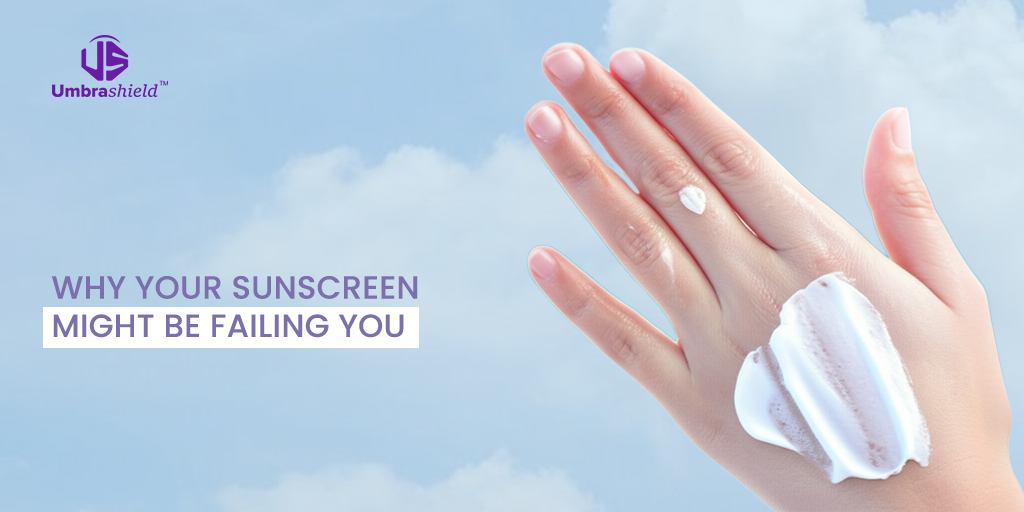
Sunscreen has long been the go-to defense against sunburns and skin damage. You apply it, step out, and assume you’re protected. But let’s be honest — how many times have you followed all the steps and still noticed tan lines or, worse, sunburn? Yep, it happens way more than it should. So what’s really going on?
The truth is, sunscreen alone might not be enough — or it’s not being used properly. In this guide, we’ll break down why sunscreen fails, the common mistakes most of us make, and why a chemical free sun protection shield like the ones from Umbrashield might be your smarter bet.
1. Sunscreen Isn’t Instant Magic
First up, most sunscreens take around 15 to 30 minutes to become effective after application. If you’re applying and rushing out the door right after, you’re basically walking outside unprotected.
What’s more? If your sunscreen isn’t broad-spectrum, you’re probably only shielding yourself from UVB rays, not UVA rays that cause long-term skin aging and pigmentation.
2. Common Sunscreen Mistakes You’re Probably Making
Here’s a quick hit list of mistakes we’ve all been guilty of at some point:
- Using too little: You need about a teaspoon for your face alone.
- Skipping reapplication: Most sunscreen needs to be reapplied every 2 hours — especially if you’re sweating or exposed to water.
- Relying on makeup with SPF: A dab of SPF foundation isn’t enough. You need a base layer.
- Not applying to all exposed areas: Ears, neck, hands — they all count.
We’re not saying sunscreen is useless — we’re saying it needs backup.
3. UV Still Gets Through – Here’s Proof
Even with proper sunscreen usage, UV damage despite sunscreen is a real thing. UV rays can penetrate through clouds, glass windows, and even thin clothing. So even if you’ve got a good SPF on, it might not be enough — especially for long days out or sensitive skin types.
That’s why more people are adding physical barriers like UV scarves, visors, and jackets into their routines.
Try this: UV Scarf – lightweight, breathable, and stylish enough for daily wear.
4. Sunscreen Breaks Down in Heat
Left your sunscreen bottle in your car or beach bag under the sun? Bad idea.
Heat and sunlight can degrade sunscreen, especially chemical-based ones. That leads to ineffective sun protection even if you’re applying it correctly.
This is one of those silent issues you don’t notice until the sunburn shows up.
5. Is Your Sunscreen Past Expiry?
Yep, sunscreen expires — and using an old one is almost as good as using none. Always check the expiry date and throw out bottles that smell weird or have separated.
6. Some Sunscreens Don’t Match Your Skin Type
If you’ve got sensitive or acne-prone skin, some sunscreens can actually cause irritation, breakouts, or even photodamage if they react to sun exposure. For individuals like this, switching to chemical-free options makes a huge difference.
And that’s where Umbrashield’s UV shields really shine.
7. What You Can Do Instead: Add a UV Shield
Want reliable protection without chemical overload or messy reapplications? That’s where a chemical free sun protection shield comes in. These physical UV shields:
- Block 99% UVA/UVB rays
- Don’t require reapplication
- Are safe for all skin types
- Don’t melt in heat or humidity
You can explore chemical free UV protection shields that are easy to wear and practical for daily commutes, errands, or even outdoor sports.
Here’s a Comparison to Make It Simple:
| Feature | Sunscreen Alone | Sunscreen + UV Shield Combo |
|---|---|---|
| Protection Duration | 2–3 hours max | All-day with no reapplication |
| Sweat/Water Resistance | Often limited | Not affected |
| Sensitive Skin Compatibility | Varies | Excellent |
| UV Blocking Efficiency | Up to 98% (with reapplication) | 99%+ without chemicals |
| Hassle-Free Use | Needs routine reapplication | Just wear and go |
8. Add-on Tools That Help
Still unsure if your sunscreen is doing its job? Try the UV Smart Mirror to actually see UV damage before it becomes visible.
Check this out: UV Smart Mirror — a portable beauty tech that shows pigmentation and dark spots under UV light. Super helpful, right?
Or you could simply add a sun protection jacket for complete upper-body protection.
FAQs: People Also Ask
- Why does my sunscreen not seem to work?
You might not be applying enough, or not reapplying it often enough. Heat exposure or expired products can also affect its efficacy. - Can you still get sunburned while wearing sunscreen?
Yes. Especially if you haven’t reapplied after sweating, swimming, or more than two hours. - What are the most common mistakes when applying sunscreen?
Using too little, skipping spots (like ears or eyelids), not reapplying, and applying too late before sun exposure. - How often should I reapply sunscreen during the day?
Every 2 hours or immediately after swimming/sweating. Physical sunscreens may last slightly longer. - Does sunscreen expire or go bad in heat?
Yes. Exposure to heat can degrade the active ingredients, making it less effective over time. - Is sunscreen enough to protect against UV damage?
Not always. Adding physical barriers like UV face shields, scarves, or protective clothing gives you more reliable coverage.
Final Thoughts — Don’t Just Rely on Sunscreen
If sunscreen is your only defense, chances are it’s not doing enough. It’s not about ditching it altogether, but about adding smarter tools — like UV shields, scarves, or jackets — that offer extended and consistent protection.
Sun safety isn’t one-size-fits-all. If you’re outdoors a lot or struggle with tanning, pigmentation, or sunscreen allergies, it’s time to rethink your routine.
